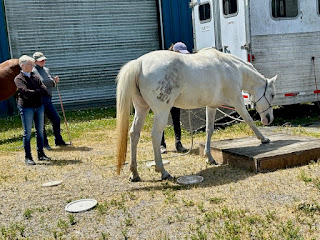by Mary Gallagher
 |
| 4-year old Je te', ponied from Harriet. |
Great beginnings. Like me, Wendy believes in natural beginnings. She spends time with the mare herd, and when the babies arrive, handles them from the beginning. Mothers and babies continue living as a herd. Colts are regularly brought into stalls for grooming and supplements, before returning to pasture for healthy socialization. In my view, this practice is key in developing solid performance horses. When Wendy’s colts arrive at Freedom Farm, they are confident, curious, and ready to learn. Thank you, Wendy for your great work. Starting these fabulous colts is such a pleasure!
Life and training at Freedom Farm. Newly arrived 2 and 3-year olds have already had a lot of experiences: they’ve been handled, haltered, in and out of stalls and horse trailers, single tied, groomed, hooves trimmed, and spent increasing amounts of time away from the herd. I build on these great beginnings, giving the colts exposure to many experiences, while going about their regular training on the ground and in the saddle. Wendy and I stay in touch often, going over new things to expose the babies to.














